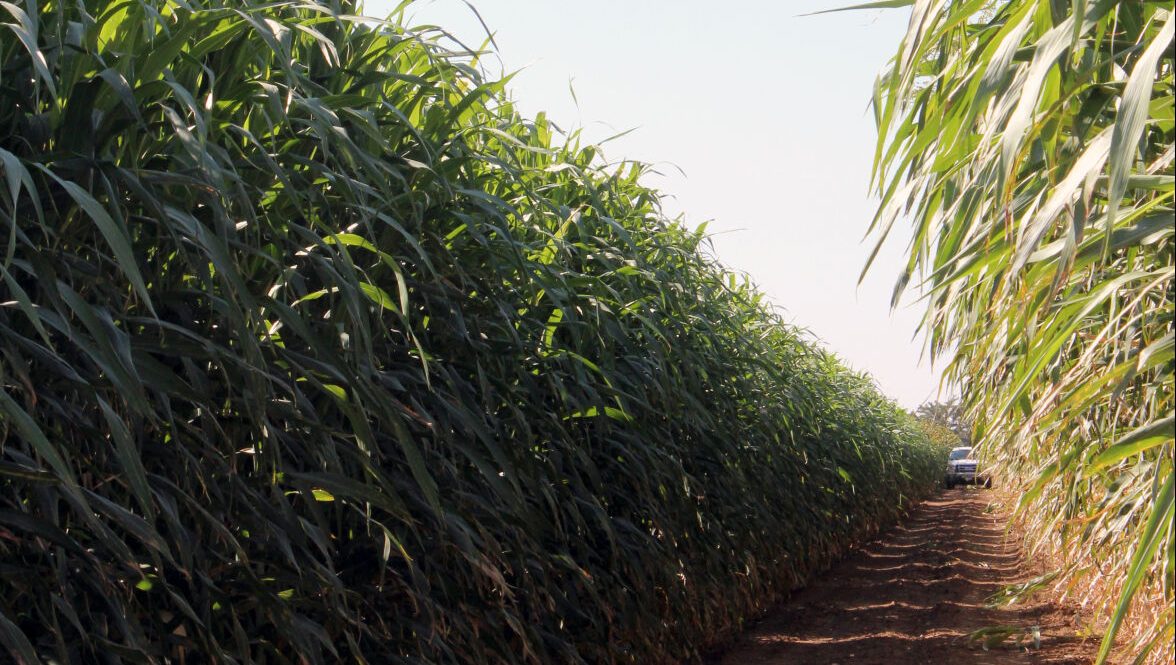Texas A&M University professor in the department of biochemistry and biophysics, John Mullet said most people will acknowledge carbon dioxide levels have been rising since the mid-1900s, but most won’t tie into how a sorghum plant can help alleviate some of the needs for fossil fuels. Mullet spoke during the recent Center for Sorghum Improvement seminar series.
Mullet focuses on sorghum, its genetics and bioenergy sorghums at TAMU, and sees how important this crop is to the fuel industry. There’s been a number of technologies developed over the last 20 years to get sorghum up to par to be a contributor to the bioenergy realm.
“(Technology that) would allow us to engineer traits in addition to selecting various traits in germ plasm,” he said.
Fossil fuels are “such a fantastic energy source” according to Mullet and being used for all sorts of products. But the consequence is increased CO2 emissions. Levels have risen steadily over the years, and he said about 35 gigaton per year are emitted.
While reversal of the increased temperatures is difficult to remedy and could be quite disruptive, many are working to mitigate those increases. If people do nothing to remedy it, levels will continue to rise to about 70 gigaton per year and then gradually decline. By the year 2100, there would be a 4 to 5 degree Celsius rise in temps globally.
“That could be pretty significantly disruptive,” Mullett said. “All the ice caps would melt; climate adjustments and changes would happen in lots of agriculturally productive regions.”
Getting to net zero greenhouse gas emissions is a huge task, especially by 2090 or 2100, he said.
So where does bioenergy from sorghum play into this? Could it be a substitution for fossil fuels or something else?
“Bioenergy sorghum may contribute to the top set of these things—renewable hydrocarbons, carbon capture and reduce nitrous oxide emissions,” he said. “There’s also a possibility that bio power or biogas generation could occur from this feedstock.”
Researchers at TAMU have been developing bioenergy sorghum hybrids for the past 25 years. Mullett said the green part of the canopy could be considered the sorghum solar cells.
“They’re very efficient C4 photosynthetic cells and they’re taking up CO2 to make hydrocarbons—that can be converted to lots of things in a bio refinery,” he said.
The sorghum plant is very drought and heat resilient according to Mullet, because it stays in the vegetative phase.
“The main attributes to this bioenergy crop are high yield of renewable hydrocarbons,” he said. “Because it stays in the vegetative phase (it) avoids the most sensitive phase of the reproductive phase which is more sensitive to drought.”
Researchers are learning more about how sorghum responds to inputs, requiring much less nitrogen fertilizer than a grain crop because it only needs to build a canopy. That reduces nitrous oxide emissions.
“Only in the last couple of years, do we realize that roots are growing more than 2 meters deep in the soil profile, and that’s a good way to sequester soil organic carbon,” Mullet said. “And also, it’s only been recently that we’ve gotten enough data to understand that this is going to produce a carbon intensity negative output from this crop.”
Mullet said carbon intensity values have been redefined in recent years, and looking back greenhouse gas displacements or energy out versus energy in rations for these types of products were measured in grams of CO2 equivalents. Equivalents could be nitrous oxide or anything that adds to the greenhouse gas emissions—the grams of CO2 equivalents per mega joule of fuel or product.
Grams of CO2 equivalents that are emitted to produce a mega joule of gasoline and the CI value there is 100. Corn grain or ethanol is 70.
“So that reduces the greenhouse gas footprint by about 30,” he said.
Sign up for HPJ Insights
Our weekly newsletter delivers the latest news straight to your inbox including breaking news, our exclusive columns and much more.
Mullet sticks with the Environmental Protection Agency recognized numbers and said if levels happen to get down to the minimal amount of nitrogen fertilizer, levels could get even lower.
“Just probably 56 kilograms per hectare will be down at minus 10,” he said. “And then if you do carbon capture at biorefineries, which is happening now in the Midwest for corn grain, you’ll be minus 130 or so. That’s pretty significant.”
People will often ask Mullet if there’s enough land available in the United States to grow bioenergy sorghum, and through research he’s found a couple points. Bioenergy sorghum varieties are more productive in southern regions where growing seasons are longer and there’s more water. One study he found suggests there’s an estimated 10 million acres in the Gulf Coastal region that could produce enough forage to make 10 billion gallons of fuel. It’s also been estimated there could be between five and 10 million acres in the Midwest.
“There’s a lot of land. (There are) interesting studies in the Midwest where 10% to 20% of the acres there are planted with corn every year and they never provide a return on investment,” Mullet said. “So it’s acreage that could be used for something that’s has lower CI values and be more productive.”
Bioenergy sorghum lines are continuing to develop and traits like sugar accumulation, waxes and deep roots will only improve, according to Mullet. He hopes the improvements will continue.
“(We’ve) developed some really excellent bioenergy sorghum hybrids that can be produced and deployed on more than 10 million acres within the US. Their carbon or carbon intensity is either zero or going to be negative,” he said. “Because of their deep root systems, low fertilizer requirements, the biomass is enriched in sugars just like sugar cane so they can be separated in a bio refinery to produce products.
Technology is now available to capture carbon, which would make this very low carbon intensity biofuel.
Kylene Scott can be reached at 620-227-1804 or [email protected].




